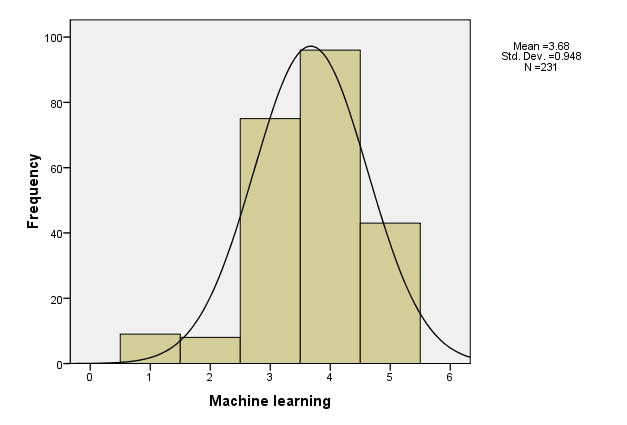Analysis of classification algorithms for Machine Learning using the SPSS Method
Main Article Content
Abstract
Machine learning, a cornerstone of computer science and artificial intelligence, encompasses the use of algorithms to replicate human learning processes and enhance accuracy. Coined by Arthur Samuel in 1959, it signifies the field where algorithms acquire learning capabilities without explicit programming, liberating machines to learn from their experiences—a hallmark of computational intelligence. Its wide-ranging applications are evident in recommender systems, such as Netflix's movie and TV show recommendations, which amalgamate collaborative and content-based filtering. Reinforcement learning further elevates recommendation systems by enabling agents to adapt suggestions based on user interactions, like tracking viewing habits. The research in machine learning holds paramount importance due to its transformative influence across various domains. It optimizes efficiency by automating intricate processes, streamlining decision-making, and expediting operations in industries spanning healthcare, finance, transportation, and manufacturing through data analysis and pattern recognition. Moreover, machine learning facilitates predictive modeling, enhancing forecasting accuracy for weather, investments, and medical diagnoses, thus aiding in informed decision-making and risk management. The abstract also briefly touches upon IBM's SPSS statistics software, a multifaceted tool for advanced analytics and data management, and alludes to Cronbach's Alpha as a reliability measure. With an overall Cronbach's Alpha value of .572, the abstract suggests its model is suitable for analysis, aligning with the literature review's findings.
Article Details

This work is licensed under a Creative Commons Attribution-NonCommercial 4.0 International License.
IJCERT Policy:
The published work presented in this paper is licensed under the Creative Commons Attribution 4.0 International (CC BY 4.0) license. This means that the content of this paper can be shared, copied, and redistributed in any medium or format, as long as the original author is properly attributed. Additionally, any derivative works based on this paper must also be licensed under the same terms. This licensing agreement allows for broad dissemination and use of the work while maintaining the author's rights and recognition.
By submitting this paper to IJCERT, the author(s) agree to these licensing terms and confirm that the work is original and does not infringe on any third-party copyright or intellectual property rights.
References
Mocanu, E., Nguyen, P. H., Kling, W. L., & Gibescu, M. (2016). Unsupervised energy prediction in a Smart Grid context using reinforcement cross-building transfer learning. Energy and Buildings, 116, 646-655. https://doi.org/10.1016/j.enbuild.2016.01.030
Tsolaki, E., Svolos, P., Kousi, E., Kapsalaki, E., Fountas, K., Theodorou, K., & Tsougos, I. (2013). Automated differentiation of glioblastomas from intracranial metastases using 3T MR spectroscopic and perfusion data. International Journal of Computer Assisted Radiology and Surgery, 8(5), 751-761. https://doi.org/10.1007/s11548-012-0808-0
Khosravi, A., Koury, R. N. N., Machado, L., & Pabon, J. J. G. (2018). Prediction of hourly solar radiation in Abu Musa Island using machine learning algorithms. Journal of Cleaner Production, 176, 63-75. https://doi.org/10.1016/j.jclepro.2017.12.065
Yau, K., Chow, K. P., Yiu, S. M., & Chan, C. F. (2017). Detecting anomalous behavior of PLC using semi-supervised machine learning. In 2017 IEEE Conference on Communications and Network Security (CNS) (pp. 580-585). IEEE.
Liu, T., Yang, Y., Huang, G.-B., Yeo, Y. K., & Lin, Z. (2015). Driver distraction detection using semi-supervised machine learning. IEEE Transactions on Intelligent Transportation Systems, 17(4), 1108-1120.
Chi, J., & Kim, H.-c. (2017). Prediction of arctic sea ice concentration using a fully data-driven deep neural network. Remote Sensing, 9(12), 1305.
Aguiar, B., Rocha, T., Silva, J., & Sousa, I. (2014). Accelerometer-based fall detection for smartphones. In 2014 IEEE International Symposium on Medical Measurements and Applications (MeMeA) (pp. 1-6). IEEE.
Wu, X., Xu, X., Wang, Y., Kaiser, W., & Pottie, G. (2016). A double-layer automatic orientation correction method for human activity recognition. In 2016 IEEE 13th International Conference on Wearable and Implantable Body Sensor Networks (BSN) (pp. 365-370). IEEE.
Mehta, P., & Tomar, P. (2016). An efficient attendance management system based on face recognition using Matlab and Raspberry Pi 2. International Journal of Engineering Technology Science and Research IJETSR, 3(5), 71-78.
Kotsalou, I., Georgoulias, P., Fourlis, S., Zoumboulidis, A., Giaslakiotis, K., Androulaki, A., Chronopoulos, P., & Dimakopoulos, N. (2008). Incidental pathologic extracardiac uptake of 99mTc-tetrofosmin in myocardial perfusion imaging. Hell J Nucl Med, 11(1), 43-45.
Muscoloni, A., Thomas, J. M., Ciucci, S., Bianconi, G., & Cannistraci, C. V. (2017). Machine learning meets complex networks via coalescent embedding in the hyperbolic space. Nature Communications, 8(1), 1615. https://doi.org/10.1038/s41467-017-01825-5
Ortega-Zamorano, F., Jerez, J. M., Gómez, I., & Franco, L. (2017). Layer multiplexing FPGA implementation for deep back-propagation learning. Integrated Computer-Aided Engineering, 24(2), 171-185.
Sajjadi, S., Shamshirband, S., Alizamir, M., Yee, L., Mansor, Z., Manaf, A. A., Altameem, T. A., & Mostafaeipour, A. (2016). Extreme learning machine for prediction of heat load in district heating systems. Energy and Buildings, 122, 222-227. https://doi.org/10.1016/j.enbuild.2016.04.021
Kulkarni, A., Pino, Y., French, M., & Mohsenin, T. (2016). Real-time anomaly detection framework for many-core router through machine-learning techniques. ACM Journal on Emerging Technologies in Computing Systems (JETC), 13(1), 1-22. https://doi.org/10.1145/2827699
Pantazi, X.-E., Moshou, D., & Bravo, C. (2016). Active learning system for weed species recognition based on hyperspectral sensing. Biosystems Engineering, 146, 193-202. https://doi.org/10.1016/j.biosystemseng.2016.01.014
Zamani Joharestani, M., Cao, C., Ni, X., Bashir, B., & Talebiesfandarani, S. (2019). PM2.5 prediction based on random forest, XGBoost, and deep learning using multisource remote sensing data. Atmosphere, 10(7), 373.
Shenify, M., Danesh, A. S., Gocić, M., Taher, R. S., Abdul Wahab, A. G., Gani, A., Shamshirband, S., & Petković, D. (2016). Precipitation estimation using support vector machine with discrete wavelet transform. Water Resources Management, 30, 641-652. https://doi.org/10.1007/s11269-015-1182-9
Wang, H., Zhou, Z., Li, Y., Chen, Z., Lu, P., Wang, W., Liu, W., & Yu, L. (2017). Comparison of machine learning methods for classifying mediastinal lymph node metastasis of non-small cell lung cancer from 18 F-FDG PET/CT images. EJNMMI Research, 7, 1-11. https://doi.org/10.1186/s13550-017-0260-9
Shanmugamani, R., Sadique, M., Ram, B., & Malviya, S. (2019). Analysis of classification algorithms for insect detection using MATLAB. In Proceedings of 2nd International Conference on Advanced Computing and Software Engineering (ICACSE).





